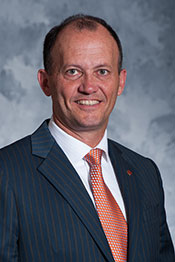 Dr. Peter Doig
Dr. Peter Doig
The experiences of our youth influence our perception of the world as we grow older. For the last 35 years, my world has been the profession of dentistry. I entered the profession as a young, eager student, graduated to be an energetic, young dentist and now assume the role of an experienced, older practitioner. My experience allows me to view our profession with a critical eye—one that has been shaped by the environment of my childhood.
I grew up on the Canadian Prairies. I was born, raised and educated in Saskatchewan and, following graduation from dental school, moved to Manitoba to begin my professional life. One of the lasting memories of my youth is the hot summer days we enjoyed in Saskatchewan. They were days of fun, freedom and adventure in a time of growth and prosperity. Often, late in the afternoon, these hot days would take on an unusual character. The wind would go still, the birds would go surprisingly quiet and the air would smell of ozone. When this happened we instinctively looked to the west because we knew what we would see: storm clouds on the horizon.
For the past 50 years, our profession has metaphorically enjoyed a long, hot summer day. Dentists have been well-respected experts in the delivery of oral health care; our profession has benefitted from developments in dental research and expanded its scope of practice; and we preached prevention of oral diseases and intervened to make improvements in oral health. The outcome of our profession’s success is the dramatic improvement in the oral health of Canadians. However, the fulfillment that comes with belonging to a profession that has contributed to the well-being of Canadians is tempered by the long-term forecast of our professional future. And like a summer day in Saskatchewan, I see the storm coming.
CDA’s annual environmental scan identifies trends in oral health care and health care in general by collecting and summarizing recent media coverage, national and international trends related to the dental care sector, and activities of special interest groups. It identifies challenges currently affecting our profession and those emerging to be future challenges. This year, some of the key challenges identified in the scan include access to care for vulnerable populations, lack of public funding for treatment of vulnerable populations, decline in public respect for the profession and a potentially bigger role for midlevel providers. Other issues were rising levels of student debt, changing demographics of dental care providers and increasing corporatization in dentistry. On the issue of human resources, the scan noted an increasing number of dentists in Canada—a trend attributed in part to an increase in the number of foreign-trained dentists licensed to practise in Canada. Yet, the distribution of dentists across the country is uneven—parts of the country continue to be underserved while other areas have a surplus. In addition, economic factors, including dental benefit plans that are less generous and the increasing costs of delivering care, are making dental care less affordable for some.
We all know it can be difficult to predict the impact of a storm. It can pass by in a bluster and do minimal damage or it could result in unimaginable devastation. This is why we must always be ready for oncoming storms. To prepare appropriately, CDA must recognize the challenges of the future and help the profession address them.
It is important to remember that challenges always present opportunities— to address issues and provide solutions in advance of crises. Dentists have the capacity to recognize, understand and mitigate the imminent challenges. The alternative—to do nothing and wait for others to take action—leaves dentistry susceptible to changes that may not be in the best interests of the oral health of Canadians or the dental profession.
It takes courage to think differently and have confidence in your own abilities to meet challenges directly. Effective problem solving needs cooperation; research has shown that diversity, rather than homogeneity, results in better group decisions. Unfortunately, for many years we have seen divisions and a lack of cooperative effort within the oral health care community, where silos have been created based on issues related to scope of practice—not best practices in oral health care delivery.
It is time for the dental profession to bring together all of those involved in health care to discuss the challenges of oral health care delivery in Canada. The discussions must identify our professional common ground, identify similar issues facing our professions, and explore cooperative efforts to address these issues. We must examine all the good programs that serve our common interests, delivered by dentists, dental hygienists and public health practitioners, and explore opportunities for broader application. We must facilitate discussions of oral health care delivery to ensure that any solutions or proposals are backed by science and follow best practices.
The National Oral Health Action Plan (NOHAP) is a CDA priority project. NOHAP will initiate discussions on the challenges of oral health care delivery at its inaugural symposium in Ottawa on February 27, 2014. These discussions will provide a starting point for developing a framework through which we can find common ground, address issues and propose solutions. Initial reactions to NOHAP have been very positive. However, as with every new initiative, there are those who believe that addressing challenges in isolation from other stakeholders will be successful and do not see the need to address the challenges we face in a broader context.
Every challenge in life provides the opportunity to be either proactive or reactive. Here is the opportunity for the dental profession to be proactive, have the courage to start a new dialogue and be confident in our position as the leaders in oral health care.
